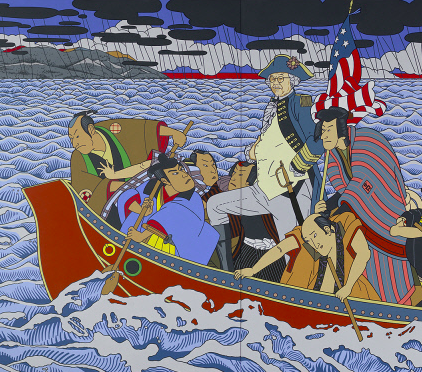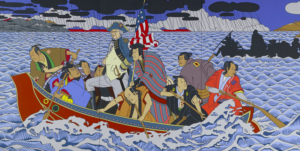
Looking Closely at Portraiture
Briana White
Smithsonian’s National Portrait Gallery
Student & Teacher Programs Manager
Overview
Portraits enable participants to make interdisciplinary connections among a variety of subject areas. In this series of lessons, museum educator Briana White works with teachers and students to explore the idea that examining contemporary portraits allows us to see ourselves in the artwork and consider how contemporary portraiture can very much be a response to global issues.
Learning Goals
By looking closely at portraiture, how might we identify and analyze key components of a portrait and relate those visual elements to relevant historical context and significance? (See elements in unit.) How do we bring these elements together to tell the story of a sitter?
UNIT/LESSON PLANS:
Context
The lesson is intended as a museum-led professional development workshop for teachers, in which teachers place themselves in the role of students, participate in the workshop, and then facilitate an adapted lesson with their own students.
For a student audience, connected subject areas include English language arts, social studies, and visual arts and art history courses. Appropriate for grades 8-12.
Key Learning Experiences
Step 1: Introducing portraiture
By looking closely at portraiture, participants are able to identify and analyze key components of a portrait and relate those visual elements to relevant historical context and significance. These key components of a portrait are the foundation by which we engage with works of art. Teachers can initiate the conversation by having students identify the various elements of portrayal in a portrait, using the questions below. (How do we bring these elements together to tell the story of a sitter?)
Facial expression: Use adjectives to describe this sitter’s facial expression. What emotion(s) does this expression convey?
Pose: Describe the sitter’s pose. What is the artist trying to say about the sitter?
Clothing: What clothing is the sitter wearing? What might the sitter’s clothing tell us about the sitter’s profession, personality, social status, or place in history?
Hairstyle: Describe the sitter’s hairstyle. Why would hairstyle be an important element of the portrait?
Setting: What is the setting of the portrait? What might the setting tell us about the sitter? Consider if the setting is real or imagined.
Objects: What objects are in the portrait? Objects function as symbols. What might they tell us about the sitter?
Color: What is color conveying in this image? How does color set the tone and mood of the portrait?
Medium: What medium was used to create the portrait? Why is medium important as we read portraiture?
Scale: What effect does the size of this portrait have on the way we view the sitter?
Artistic style: What does this artist’s particular style tell us about the sitter?
Portraits enable participants to make interdisciplinary connections among visual arts and art history, social studies, and English/language arts. By examining contemporary portraits, participants begin to see themselves in the artwork and consider how contemporary portraiture can very much be a response to global issues.
The learning goals at the Portrait Gallery always center on slowing down, inviting visitors to take a closer look at portraits, and to make meaning of what they see (and experience). Learning goals, developed in conjunction with teachers and students, focus on how portraits can be used in an interdisciplinary way, across the curriculum. Finally, the museum’s mission to tell the story of America through the people who have shaped our country and our culture lends itself to a national conversation, but having a global conversation is just as, if not more, important.
Step 2: Exploring Shimomura Crossing the Delaware
(Unveiling Stories global thinking routine)

Shimomura Crossing the Delaware
By Roger Shimomura
Acrylic on canvas, 2010
National Portrait Gallery, Smithsonian Institution;
Gift of Raymond L. Ocampo Jr., Sandra Oleksy Ocampo, and Robert P. Ocampo
© Roger Shimomura
- Start with a minute of quiet looking.
- Discuss initial observations with a partner. Share out.
- Compare to Washington Crossing the Delaware by Emanuel Leutze, oil on canvas, 1851, Metropolitan Museum of Art; Gift of John Stewart Kennedy, 1897.
- Discuss additional observations with a partner.
- As a group, use the Unveiling Stories Thinking Routine to deepen student engagement:
- What’s the story? This is where we synthesize the observations we made initially, and where we discuss the overarching theme of the image.
- What’s the human story? We consider the person-centered experience: How does the story help us understand the lives of our fellow human beings around the world?
- What’s the world story? What global issues today does this painting reveal for us?
- What’s the new story? What is new and instructive about the issue explored?
- At this point, tell viewers that Roger Shimomura is third-generation Japanese American, and that as a small child, he spent two years in an internment camp in Idaho during WWII.
- What’s the untold story? What are the important absences of the story? What could be happening beyond the frame of the portrait?
Here are some additional close looking and analysis questions to consider asking while utilizing the Unveiling Stories thinking routine:
Portrait Observations
-
- Describe what each sitter is wearing. How are their outfits similar, and how are they different?
- Describe the setting of this portrait. What type of landscape do you see in the background?
- What objects do you see in the portrait?
- Describe the sitters’ facial expressions. In what direction are they looking?
Portrait Analysis
-
- How do the different elements in the portrait combine to tell the story? Consider the setting, clothing, pose, facial expressions, and objects.
- What can you tell about the sitters based on their clothing?
- How can we interpret the presence of the objects found in the painting?
- Why might the artist have arranged the sitters in these particular poses? What can we determine about the relationship among the sitters?
- How is Americanism and patriotism reflected in this portrait? Why would the artist include these elements?
Background information:
Utilizing Shimomura Crossing the Delaware by Roger Shimomura often leads to thoughtful conversations about immigration, Japanese internment, identity, appropriation, etc.—topics that certainly enable us to consider our past, present, and future, but also our place in a global world.
Roger Shimomura (b. 1939), a Japanese American artist, combines American culture with Asian traditions to create artworks—paintings, prints and performances—that play on Asian stereotypes and create thought-provoking questions about racial and cultural identity. During World War II, Shimomura and his family were imprisoned at a camp in Idaho, indicative of the widespread xenophobia taking place at that time.
During his time as a professor at the University of Kansas, Shimomura used his art to explore the complexities of American cultural identity and the challenges of being of Asian descent in the United States. Shimomura combines the traditional “look” of Japanese culture and American material culture to draw his audience’s attention to the unconscious stereotypes that are all too often overlooked. While at the University of Kansas, Shimomura faced questions from people around him about how long he had lived in the United States or what part of Japan he was from. Shimomura noted the confusion on their faces when he answered that he was from Seattle, signaling the idea that “American-born citizens of Asian descent continue[s] to be thought of as only ‘American knockoffs.’” Aware of the controversial nature of his work, Shimomura reflects, “If my work is seen as raising more questions than it answers, I’d be pleased, because I’m not sure what those answers are.”
What if George Washington had been Japanese American? With this thought, Shimomura created Shimomura Crossing the Delaware (2010), a play on Emanuel Leutze’s 1851 painting, Washington Crossing the Delaware. He placed himself in the iconic pose as Washington but replaced the Continental army soldiers with Japanese samurai. In addition, Shimomura remakes the body of water they cross to resemble San Francisco Harbor, with Angel Island (the processing center for Asian immigrants) in the background. The work echoes the compositional format of a Katsushika Hokusai woodblock print.
Step 3: Deepening understanding of global issues
Should the teacher decide to extend the conversation in the classroom about any of the following topics, below are additional portraits to compare/contrast/connect to Shimomura Crossing the Delaware.
Japanese Internment during World War II:
Fred T. Korematsu
By an unidentified artist
Gelatin silver print, 1939
National Portrait Gallery, Smithsonian Institution; gift of the Fred T. Korematsu Family
Fred T. Korematsu
By an unidentified artist
Gelatin silver print, c. 1940
National Portrait Gallery, Smithsonian Institution; gift of the Fred T. Korematsu Family
Identity:
See Emily Veres’ lesson plan from the Washington International School, which uses National Portrait Gallery images to take a close look at identity.
Stereotypes:
Rosa Parks
By Marshall Rumbaugh
Painted limewood, 1983
National Portrait Gallery, Smithsonian Institution
Step 4: Culminating learning experience
For teachers looking to facilitate the Unveiling Stories thinking routine in the classroom, the culminating learning experience is the self-guided time needed to find another portrait that will work well with the routine and with their students. It is especially important to end the workshop with this activity while the teacher still has the support of the museum staff and the other teachers attending the workshop.
Museum Educator Reflections
Through a thoughtful examination of Shimomura Crossing the Delaware, teachers—and in turn students—are encouraged to see the potential for portraiture as an invitation to investigate the world. Shimomura Crossing the Delaware easily connects to identity, a conversation about stereotypes, US history, world history, art history, visual arts, and English language arts. The Unveiling Stories routine can connect to all of these same topics as well (depending on the chosen artwork), which is why Shimomura Crossing the Delaware is such a great fit for this particular thinking routine.
Should an educator use global thinking routines, surround yourself with other educators who are interested in this approach, take your time to experience the thinking routines before facilitating them, and create a working group to consider this idea of educating for global competence.
The challenge (and benefit) of teaching with artwork is that there is no one right answer, but facilitators have to be flexible with the direction of the dialogue, depending on the participants’ responses. The Unveiling Stories thinking routine can certainly be used with other images, but artwork choice can be challenging. Knowing the contextual information, or backstory of the image, is key to deciding whether to use a specific image or not.
Researcher Reflections
Similar to Heidi Hinish’s lesson on Green River Hills, Wyoming, Briana ensures that participants in her workshop look slowly at the chosen artwork before delving into the global thinking routine. She has chosen Unveiling Stories for its potential to take learners more deeply into a portrait and to consider multiple angles for interpretation. This lesson is built around the idea of discovery. Briana reveals key information at opportune moments but ensures that participants have the chance to explore before sharing the backstory.
Briana has led this workshop with numerous groups–of teachers and students. The artwork possesses layers of complexity and, paired with the global thinking routine, has proven to be accessible to most secondary school students. It also can raise issues of inspiration and appropriation, as Shimomura based his painting on the iconic Leutze painting.

